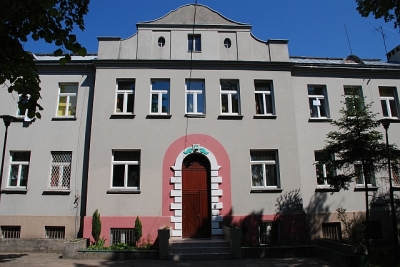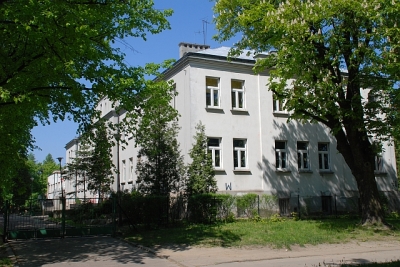During the ghetto years, Marysinska Street ran a slightly different way than it does today. It started at Chlodna Street (which no longer exists), cut through Brzezinska Street (what is today Wojska Polskiego Street) and stretched to the northern border of the ghetto.
In the autumn of 1941, a tram line started operating. The trams rumbled along Brzezinska Street, later Marysinska and Jagiellonska (now Kolinskiego) streets to the Radogoszcz railway station in Marysin. The trams transported food, other goods and fuel, and, beginning in 1943, also the workers employed in Marysin [see: The trams in the ghetto].
At 48 Marysinska St., Primary School No. 25 operated until the autumn of 1941. Later, the Jewish deportees from Prague (known as Collective "Prague III") were housed here.
What was called the Issuing Bank, which Rumkowski opened on June 26, 1940, was located at 71 Marysinska St. It was Friedrich Uebelhoer, the president of the Kalisz-Lodz Region, who decided to set up such a banking institution. The bank's responsibility was to supervise the issuing of special currency used in the ghetto. The money was officially called "marks" but was generally known as "rumki" in reference to Rumkowski.
Starting on July 8, 1940, this was the only legal currency in the ghetto; it had no value whatsoever outside the ghetto walls. This was the "money" Jews received when they sold jewellery, fur coats, foreign currency and other valuables during their struggle in the ghetto.
 The beautiful building at 100 Marysinska St. in Marysin, which still stands today, was initially an orphanage. Later, the German authorities ordered that the children be moved out and the structure was officially deemed outside of the ghetto borders. In February 1941, the young orphans were moved to the junior high school building at 102 Franciszkanska St., where all ghetto orphans were gathered. Beginning in the autumn of 1941, the Marysinska Street building was reinstated within the ghetto border. The Shoemaking Workshop was then located here. It produced slippers and the upper parts of shoes.
The beautiful building at 100 Marysinska St. in Marysin, which still stands today, was initially an orphanage. Later, the German authorities ordered that the children be moved out and the structure was officially deemed outside of the ghetto borders. In February 1941, the young orphans were moved to the junior high school building at 102 Franciszkanska St., where all ghetto orphans were gathered. Beginning in the autumn of 1941, the Marysinska Street building was reinstated within the ghetto border. The Shoemaking Workshop was then located here. It produced slippers and the upper parts of shoes.
After the war the building once again became an orphanage. It is still an orphanage today.
On September 9, the ghetto received back the orphanage building at 100 Marysinska St., which was taken away at the beginning of this year. This luxurious building was not used at all during that time. Although the building with the surrounding large orchard was formally re-incorporated into the ghetto, and the border wire fences were shifted, its bequest to the
 district was suspended. Reportedly, the final decision on this issue was not yet made by the German authorities. In the event the district receives it, the building will be assigned to a labor department.
district was suspended. Reportedly, the final decision on this issue was not yet made by the German authorities. In the event the district receives it, the building will be assigned to a labor department.
The Chronicle of the Lodz Ghetto, September 1941, Vol. 1, p. 252.
The motorization of the ghetto is proceeding. A tram line is reportedly being installed between Marysin and the city, in order to transport goods and food. Both are supplied to the ghetto in enormous quantities and horse-drawn carts are insufficient. Trucks from various German forwarding companies are used, but they are only "borrowed." We need our own transportation system! The ghetto, which is gradually turning into a Jewish workers' center of the Reich, must be motorized! This is the latest slogan! I am losing my cool when I think that it looks as if it was to last long.
Dawid Sierakowiak, Diary, September 9, 1941, p. 54.
The extension of tram service began in November, when one tram car was placed at the ghetto authorities' disposal. Also in November, the ghetto received four other motor tram cars, imported from Germany. These are open cars of the summer variety. The Board of the tram communication company, managed by Engineer Dawidowicz, is located in a barrack in Balucki Rynek. In November, the work to lay the rails along Marysinska Street towards Marysin, beginning at the corner of Brzezinska Street, continued at the fastest possible pace.
The Chronicle of the Lodz Ghetto, November 1941, Vol. 1, p. 273.
The shoe making workshop is celebrating its "birthday." The workshop was established exactly a year ago and is located at 100 Marysinska St., where it was originally started; it is managed by Bornstein. On this occasion, the workshop received a donation of 6,000 marks for the relief fund and one free coupon for every worker.
The Chronicle of the Lodz Ghetto, October 27, 1942, Vol. 2, p. 322.

 Home
Home
